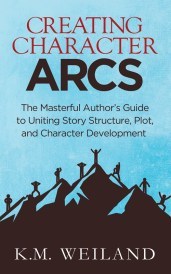Supporting Characters and Theme: 6 Important Questions to Ask About Your Story
 Raise your hand if you’ve ever written in a new supporting character just because, hey, somebody had to start that tavern brawl. Creating delightfully colorful, unexpected, and sometimes just plain convenient minor characters is half the fun of writing. That said, we might all want to now sit on those hands we raised. However random our supporting cast may sometimes seem, writers mustn’t overlook the crucial correlation between supporting characters and theme.
Raise your hand if you’ve ever written in a new supporting character just because, hey, somebody had to start that tavern brawl. Creating delightfully colorful, unexpected, and sometimes just plain convenient minor characters is half the fun of writing. That said, we might all want to now sit on those hands we raised. However random our supporting cast may sometimes seem, writers mustn’t overlook the crucial correlation between supporting characters and theme.
In short, the more important your supporting characters, the greater your responsibility to ensure they contribute more than just that first punch to get the conflict going. Once you’ve properly set up the foundations of your story’s thematic presentation (via your protagonist’s arc and your antagonist’s generation of the plot conflict), your supporting characters are going to provide your greatest opportunity for deepening the complexity, maturity, and subliminal power of your story’s thematic premise.
I’m going to repeat an analogy I’ve used before because it’s one of my favorite ways to view theme:
Think of your overall theme as a big mirror smashed on the floor. The biggest chunk of glass is your protagonist. The second biggest is your antagonist. And every other shard represents every other character. They all reflect the theme. They all show a different piece of the big picture.
Naturally, the bigger the piece of glass—the bigger the character’s role—the more explicit its relationship to theme should be. But ideally even the walk-on character with no lines can present symbolic opportunities. Think about it: the character who starts that tavern brawl could be a drunken miner, a bartender, a little girl, a fancy gambler, or the landlady. Even if that’s all that character contributes to the story, each choice is going to say something a little different within the context.
If dreaming up thematic significance for each and every supporting character sounds like a lot of work, don’t worry. With a little practice, using thematic criteria to choose or groom supporting characters will become second nature. More than that, it’s a fun and effective way to create a surprising and dimensional cast.
6 Questions to Refine Your Supporting Characters and Theme
To help you get a sense of how your supporting characters can play a defining role in strengthening and deepening your story’s theme, here are six questions. Eventually, these questions should become instinctive, but until then you can use them as a reminder of ways in which you can spot and take advantage of missed opportunities.
1. How Does Each Supporting Character Represent the Theme?
Take a moment to scan your cast. If every character is pertinent to the forward progression of your story’s plot, then there’s already a strong probability these characters have a strong thematic impact as well. Still, it’s easy to miss the forest for the trees. For that matter, thematically vetting supporting characters can be a great way to spot weak spots in their relation to the plot as well.
Refer to the question inherent within your story’s thematic premise. Is each prominent character asking (or answering) some version of this question?
For example, if your story is about duty, your characters may ask any range of questions from “What is duty?” to “Do I owe duty to a tyrant?” to “Can doing your duty go against your conscience?” to “Am I hiding behind my duty?” to “Am I hiding from my duty?”
The more varied the questions, the more opportunities you will have to explore your thematic premise from every angle.
2. Which Supporting Characters Reflect Positively on the Theme and Which Reflect Negatively?
To create a well-rounded exploration of theme, you will want to look at it from as many angles as possible. Some characters should argue for the thematic Truth; others should argue just as passionately and logically against it. (If you at least occasionally find yourself almost convinced by your antagonist’s arguments, you know you’re doing a good job.)

There’s little point to having multiple characters represent the same thematic position within the story. Look for as much variety as possible. See if you can create a character who will represent at least each of the following:
A stalwart, unchanging relationship with the Truth.
A stalwart, unchanging relationship with the Lie.
A change arc from Lie to Truth.
A change arc from Truth to Lie.
3. Which Characters Will Influence Your Protagonist’s Relationship to the Theme and Which Will Be Influenced By the Protagonist?

Your protagonist’s relationship to the plot and the theme is your story. It’s the structural and symbolic backbone that proves whether the whole thing works or not. When it comes right down to it, your supporting characters only matter to the story insofar as they move the needle on the protagonist’s relation to the plot and/or the theme (preferably both, of course).
If for the moment we simplify the idea of theme to a question, then the supporting characters will reflect that theme by positing various answers. Some of those answers may help the protagonist find the ultimate thematic Truth he needs to win or transcend the plot’s physical conflict. Other answers may be convincing in their ability to tempt him away from that Truth but ultimately negative in their impact upon the ending.
It may also be that a supporting character is impacted by the protagonist as much or more than the protagonist is impacted by the supporting character. Especially when the protagonist is demonstrating a Flat Arc (in which he is largely unchanging in representing the story’s thematic Truth throughout), the supporting characters may be the ones most changed by the theme.
4. How Does Each Minor Character’s Personal Goal/Conflict Comment Upon the Theme?
Now that you’ve examined your supporting characters’ contribution to your story’s thematic big picture, it’s time to get a little grittier. It’s not enough simply to identify the personal beliefs that align a supporting character with either the Truth or the Lie. You must make sure those personal mindsets are demonstrated (aka, shown not told) on the scene level in ways that actually move the needle on the plot.
The easiest way to gauge this is to consciously choose your supporting characters’ personal goals, first within the plot as a whole, then within each scene. In the busyness of making sure your protagonist’s goal and conflict are happening in each scene, it can often be easy to overlook the causal and thematic importance of each and every supporting character’s scene goal. Paying attention to supporting characters’ scene motivations and desires will not only amp their credibility as whole human beings, it will also provide incredible opportunities for deepening the holistic complexity of your plot conflict and your thematic argument.
5. How Does Each Supporting Character’s Climactic Moment Reflect Your Protagonist’s Thematic Climax?
Your protagonist provides both the structural and thematic throughline for your story. It’s her Climatic Moment that will end the conflict and “prove” the thematic premise. Your supporting characters are there to support that outcome. They should not overshadow the importance of the protagonist in these finale moments. (If any character other than the protagonist takes center stage in the Climax, you have to ask if you’ve chosen the right protagonist.)
Some of your supporting characters may be present in the actual Climax, but many others will offer their final impact on the plot in earlier scenes. Either way, look for opportunities to end these characters’ thematic conversations in ways that snowball into the protagonist’s finale.
This might look like any of the following:
The supporting character actively influences the protagonist in moving toward the thematic end.
The supporting character is directly influenced by the protagonist’s thematic choices in the Climax.
The supporting character symbolically foreshadows or reflects the protagonist’s end, either supportively or ironically.
6. What if a Supporting Character Doesn’t Provide a Thematic Reflection?
Now we come to the final important question you can ask about your supporting characters. What if they don’t have any relationship with or reflection upon the theme?
First of all, don’t panic. Not every character has to comment upon the theme. That character who started our tavern brawl may not need to offer anything more than the first punch to get the scene rolling. But here are two rules of thumb for judging whether you’re missing an opportunity for thematic depth or, in some cases, risking a huge theme hole:
1. The smaller your cast, the tighter your thematic representation must be.
If your story is Death of a Salesman with only a dozen characters, then every character matters. The specificity of every character, within both the plot and the theme, must be drawn sharply. If, however, your story presents the proverbial cast of thousands, you’ll have much more room for error.
2. The more important the character, the bigger the thematic footprint must be.
Although there may be occasional characters whose impact far outweighs their actual screen time, usually their importance within the story can be judged on the size of their roles. Walk-on characters with no lines clearly land at the bottom of the pecking order, while archetypal allies and enemies command the most influence upon plot and theme. You can get away with colorless and meaningless walk-ons, but the more scenes in which certain characters appear and the more dialogue they have, the greater their thematic importance.
Basically, if a character is moving the plot, that character should be vetted for thematic integrity.
***
Although not always immediately apparent, supporting characters and theme are made to serve one another. If your supporting cast is solid, that’s a good indication you’re executing your theme solidly as well. And if your theme is progressing nicely, it’s probably a good sign you’ve created a memorable and pertinent cast of supporting characters. Using theme to vet supporting characters (and vice versa) is one of your best tools for pulling off a solid and holistic story. Try it out!
Wordplayers, tell me your opinions! How have you consciously paired your supporting characters and theme in your story? Tell me in the comments!
http://www.podtrac.com/pts/redirect.mp3/kmweiland.com/podcast/supporting-characters-and-theme.mp3
Click the “Play” button to Listen to Audio Version (or subscribe to the Helping Writers Become Authors podcast in iTunes).
The post Supporting Characters and Theme: 6 Important Questions to Ask About Your Story appeared first on Helping Writers Become Authors.



